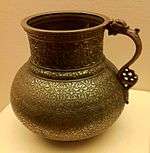Timurid art
Timurid art is a style of art originating during the rule of the Timurid Empire (1370-1507). Timurid art was noted for its usage of both Persian and Chinese styles, as well as for taking influence from the art of other civilizations in Central Asia.[1] After the decline of the Timurid Empire, the art of the civilization continued to influence other cultures in West and Central Asia.[1][2]

History
The Timurid Empire was established by Timor the Lame in 1370 after the conquest of the various Ilkhanate successor states. After conquering a city, the Timurids commonly spared the lives of the local artisans and deported them to the Timurid capital of Samarkand. After the Timurids conquered Persia in the early 15th century, many Persian artistic traits became interwoven with existing Mongol art. Timor the Lame's conversion to Islam later in life made Samarkand one of the centers of Islamic art. In the mid 15th century the empire moved its capital to Herat, which became a focal point for Timurid art. As with Samarkand, Persian artisans and intellectuals soon established Herat as a center for arts and culture. Soon, many of the Timurids adopted Persian culture as their own.[3]
Illustration
Timurid art absorbed and improved upon the traditional Persian concept of the "Arts of the Book". The new, Timurid-inflected works of art saw illustrated paper (as opposed to parchment) manuscripts produced by the empire's artists. These illustrations were notable for their rich colors and elaborate designs.[4] Due to the quality of the miniature paintings found in these manuscripts, Suzan Yalman of the Metropolitan Museum of Art noted that "the Herat school [of manuscript painting] is often regarded as the apogee of Persian painting."[1] Painting was not limited to manuscripts, as many Timurid artists also created intricate wall paintings. Many of these wall paintings depicted landscapes derived from both Persian and Chinese artistic tradition.[5] While the subject matter of these paintings was borrowed from other cultures, Timurid wall paintings were eventually refined into their own, unique style.[6] Mongol artistic traditions were not entirely phased out, as the highly stylized depictions of human figures seen in 15th century Timurid art are derived from this culture.[7]
Metalwork, ceramics, and carving
The Timurid Empire also produced quality pieces of metalwork. Steel, iron, brass, and bronze were commonly used as mediums.[8] Timurid silver-inlaid steel is often being cited as being of particularly high quality.[9] Following the collapse of the Timurid Empire, several Iranian and Mesopotamian cultures co-opted Timurid metalwork.[8]
Chinese-style ceramics were produced by Timurid artisans. Jade carving also had some presence in Timurid art.[1]
Legacy
Following the decline of the Timurid Empire in the late 15th century, the Ottomans, Safavid dynasty, and Mughal Empire co-opted Timurid artistic traditions into their own.[2][1]
Gallery
 A Timurid carved jade sword hilt.
A Timurid carved jade sword hilt. Timurid-inspired image of Babur.
Timurid-inspired image of Babur. 15th century Timurid tankard made in Herat.
15th century Timurid tankard made in Herat.
References
- Komaroff, Authors: Suzan Yalman, Linda. "The Art of the Timurid Period (ca. 1370–1507) | Essay | Heilbrunn Timeline of Art History | The Metropolitan Museum of Art". The Met’s Heilbrunn Timeline of Art History. Retrieved 2017-11-16.
- "The Timurids and the Turkmen - The David Collection". www.davidmus.dk. Retrieved 2017-11-16.
- B.F. Manz; W.M. Thackston; D.J. Roxburgh; L. Golombek; L. Komaroff; R.E. Darley-Doran (2007). "Timurids". Encyclopedia of Islam, online edition. "During the Timurid period, three languages, Persian, Turkish, and Arabic were in use. The major language of the period was Persian, the native language of the Tajik (Persian) component of society and the language of learning acquired by all literate and/or urban Turks. Persian served as the language of administration, history, belles lettres, and poetry."
- "Iransaga - Persian Art, The Timurids". www.artarena.force9.co.uk. Retrieved 2017-11-16.
- "Timurids" The Columbia Encyclopedia (Sixth ed.). New York City: Columbia University. Retrieved 2006-11-08.
- Lentz, W. Thomas. Dynastic Imagery in Early Timurid Wall Paintings. Los Angeles Museum of Art. URL:https://archnet.org/system/publications/contents/4320/original/DPC0599.pdf?1384784647
- Blair, Sheila, and Bloom, Jonathan M., The Art and Architecture of Islam, 1250–1800, Chapter 5, 1995, Yale University Press. Pelican History of Art, ISBN 0300064659.
- electricpulp.com. "METALWORK – Encyclopaedia Iranica". www.iranicaonline.org. Retrieved 2017-11-16.
- The Caspian Sea Journal ISSN: 1578-7899 Volume 10, Issue 1, Supplement 3 (2016) 127-132 The Compilation of One Object of Timurid Metalwork (12th Century) in the National Museum of Iran with Two Objects in National Museum of Yerevan-Armenia. URL: http://csjonline.org/CSJ/2016/Supp3/127-132.pdf